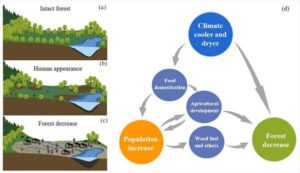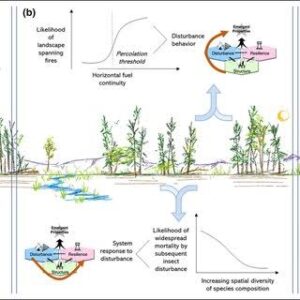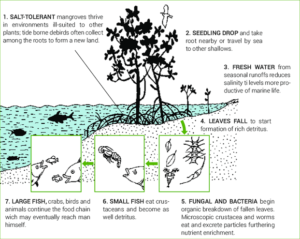Back to: Botany 300 Level
Hello, my amazing Afrilearn scholar! I hope you’re feeling great today, ready to tackle another important lesson! Have you ever visited a wetland or mangrove area? If you have, you’ve probably seen how rich and alive these places are. If not, no worries—we’re going to explore their ecological roles together! Wetlands and mangroves are often considered nature’s kidneys and coastal protectors because they play critical roles in both the environment and human well-being.
Today, we’re going to focus on understanding the functions of wetlands and mangroves in ecosystems and how they help us. Trust me, you’ll be amazed by how important these ecosystems are, even though they sometimes get overlooked. Let’s get started!
Ecological roles of wetlands and mangroves
What Are Wetlands and Mangroves?
Wetlands are areas of land that are saturated with water for long periods of time. They can be freshwater or saltwater and include marshes, swamps, and bogs. Wetlands are typically found near lakes, rivers, and coasts.

Mangroves, on the other hand, are a specific type of wetland that exists along coastal areas, where saltwater from the sea meets freshwater from rivers or rain. Mangroves are unique because they have special adaptations to survive in salty water, such as specialised roots that filter salt.
Now, let’s explore the key ecological roles of both wetlands and mangroves!
1. Biodiversity Hotspots
One of the most important roles of both wetlands and mangroves is supporting a huge variety of life. These ecosystems are home to numerous species of plants, animals, and microorganisms, many of which rely on them for shelter, food, and breeding grounds.
Wetlands are often described as biodiversity hotspots. They support diverse species of birds, fish, amphibians, reptiles, and insects. Many migratory birds, such as ducks and herons, stop at wetlands during their long migrations.
Mangroves also support unique wildlife, including crabs, fish, and mangrove trees like the red mangrove. Many fish species, like tilapia and shrimp, depend on the protected waters of mangrove forests during their juvenile stages before moving into the open sea.
Example:
In Nigeria, the Niger Delta is home to both wetlands and mangroves. These ecosystems provide shelter for birds like the African fish eagle, and support marine life like oysters and shrimp that are vital to local fishing communities.
2. Water Filtration and Purification
Wetlands and mangroves are often referred to as nature’s filters. These ecosystems play an important role in improving water quality by trapping pollutants such as excess nutrients, chemicals, and sediment. The plants and microorganisms in wetlands and mangroves naturally filter the water, making it cleaner for both wildlife and humans.

Wetlands act as natural sponges, soaking up excess water during heavy rains and slowly releasing it, which helps to filter out pollutants.
Mangroves also play a similar role by filtering out salt, excess nutrients, and sediments from coastal waters. Their roots trap soil and keep it from being washed away by the tides, preventing coastal erosion.
Example:
The Lekki Conservation Centre in Lagos, Nigeria, is a wetland area that helps filter stormwater runoff from the surrounding urban areas. This prevents the pollution from reaching the ocean and harming marine life.
3. Carbon Sequestration
Did you know that wetlands and mangroves are among the most effective ecosystems for storing carbon? They absorb and store carbon dioxide from the atmosphere, helping to regulate the Earth’s climate and reduce the effects of climate change.
Mangroves are particularly effective in carbon storage because their dense root systems trap large amounts of carbon in the soil, where it can remain stored for centuries.
Wetlands store carbon in their soils, and they also support plants that capture and store carbon during photosynthesis.
Example:
The Gulf of Guinea, which includes parts of Nigeria’s coastal region, has vast areas of mangrove forests that help absorb carbon dioxide, mitigating the effects of global warming. Without these ecosystems, more carbon would be released into the atmosphere, accelerating climate change.
4. Coastal Protection and Erosion Control
One of the most crucial roles of mangroves is their ability to protect coastal areas from erosion and storm damage. The tangled root systems of mangrove trees form a natural barrier that helps absorb the energy of waves, reducing the impact of storms and high tides.
Mangroves act like a coastal shield, preventing the erosion of coastlines, which helps protect shoreline communities and their homes from floods and storm surges.
Wetlands also help with erosion control. They act as natural buffers, slowing down the flow of water and allowing it to be absorbed into the ground instead of running off and eroding the land.
Example:
In Nigeria, the Niger Delta’s mangrove forests play a critical role in protecting the coastal areas from the damaging effects of ocean waves, especially during the rainy season when storms are more frequent.
5. Livelihood and Cultural Importance
Wetlands and mangroves are not just valuable for the environment—they are also crucial to local communities. In many parts of Nigeria, wetlands and mangroves support local economies by providing resources like fish, timber, and medicinal plants.
People living near mangrove forests harvest firewood, mangrove bark (used in traditional medicine), and shellfish.

Wetlands support agriculture and fishing communities by providing fertile land and clean water for crops and fish.
Example:
In the Niger Delta, communities rely on the mangrove ecosystem for fishing and agriculture. They also use the mangrove trees for making furniture and traditional medicines.
Summary
Wetlands and mangroves are invaluable ecosystems that play a variety of ecological roles:
They are biodiversity hotspots, supporting a wide range of species.
They act as natural filters, purifying water and improving water quality.
They help in carbon sequestration, reducing the effects of climate change.
They provide coastal protection, preventing erosion and flooding.
They support local livelihoods through fishing, agriculture, and the use of resources.
It’s clear that wetlands and mangroves are not just beautiful places, but crucial ecosystems that contribute to the health of our planet. We must work to protect them from destruction and degradation.
Evaluation
- What are wetlands and mangroves, and where can they be found?
- How do wetlands improve water quality?
- Why are mangroves important for coastal protection?
- How do wetlands and mangroves help with carbon sequestration?
- In what ways do mangroves support local communities?
Awesome work today! Now you know why wetlands and mangroves are so important to our world. I’m so proud of how much you’ve learned today. Keep up the fantastic work, and I can’t wait to see you in our next lesson! You’re doing great—keep learning and growing!
